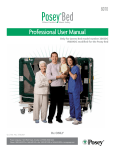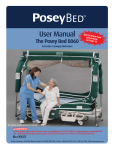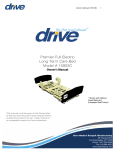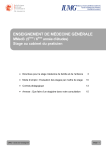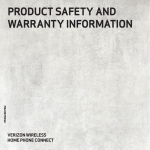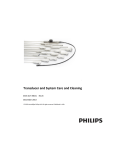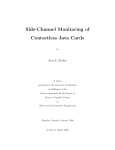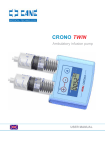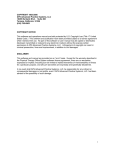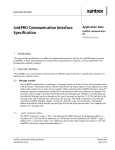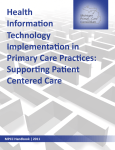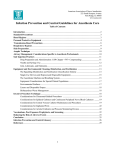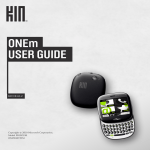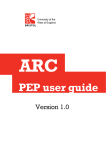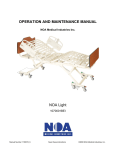Download Posey® Bed 8070 Professional User Manual
Transcript
Posey Bed 8070 ® User Manual Only for Invacare SC900DLX Bed modified for the Posey Bed Rx ONLY U.S. Patent No.7,735,167 How to Use this Manual INTRODUCTION This User’s Manual is intended as a guide for those using the Posey Bed 8070 in the care of patients, and who have successfully completed training. Proper training in the use of the Posey Bed 8070 is important and is provided by your authorized Posey Bed dealer or Posey Company sales representative. In addition to this manual, you should also review: 1. The Assembly Instructions 1. The In-Service Training Manual SYMBOLS The symbols below are used throughout this manual and should be read carefully. A warning alerts you to a safety hazard or unsafe practice, which, if not avoided, could result in serious injury or death. A caution alerts you to a hazard, which, if not avoided, may result in minor or moderate injury to you or the patient, or damage to the Posey Bed. NOTE A note provides helpful information to make bed use easier and more efficient. DEFINITIONS The following words have specific meaning when used in this manual: Biohazardous – material that is contaminated with human blood, tissues, certain body fluids, recombinant DNA or pathogens. Check with the patient’s doctor if you have any questions about this hazard. Care Plan – the patient’s individualized care plan (ICP) as written by the IDHT (see below). Interdisciplinary Healthcare Team (IDHT) – the team that writes the care plan (or ICP) and supervises patient care. Team members may include, among others, doctors, nurses, occupational therapy staff, physical therapy personnel and social services workers. Entrapment – an event in which a patient is caught, trapped or entangled in a confined space. This can result in serious injury or death from suffocation, compressions or lack of proper blood flow. NEED HELP? 2 Please call the Posey Company Customer Support at 1.800.447.6739 between 6:00 a.m. and 5:00 p.m., Pacific time, or contact your authorized bed dealer. www.posey.com 1.800.447.6739 Posey Bed 8070 Table of Contents Welcome to the Posey Bed 8070. . . . . . . . . . . . . . . . . . . . . . . . . . . . . . . . . . . . . . . . . . . . . . . . . . 4 About the Posey Bed 8070 . . . . . . . . . . . . . . . . . . . . . . . . . . . . . . . . . . . . . . . . . . . . . . . . . . . . . . 5 Contraindications (When the Bed Should Not be Used) . . . . . . . . . . . . . . . . . . . . . . . . . . . . . . . . . . . . . . . . . 6 A Special Note . . . . . . . . . . . . . . . . . . . . . . . . . . . . . . . . . . . . . . . . . . . . . . . . . . . . . . . . . . . . . . . . 7 Patient Reassessment. . . . . . . . . . . . . . . . . . . . . . . . . . . . . . . . . . . . . . . . . . . . . . . . . . . . . . . . . . 8 Special Considerations for Home Care Environments. . . . . . . . . . . . . . . . . . . . . . . . . . . . . . . 8-9 Description of the Posey Bed 8070. . . . . . . . . . . . . . . . . . . . . . . . . . . . . . . . . . . . . . . . . . . . . . . . 9 Components of the Posey Bed 8070 System . . . . . . . . . . . . . . . . . . . . . . . . . . . . . . . . . . . . . . . 10 Warnings and Precautions. . . . . . . . . . . . . . . . . . . . . . . . . . . . . . . . . . . . . . . . . . . . . . . . . . . . 11-13 Basic Bed Operation. . . . . . . . . . . . . . . . . . . . . . . . . . . . . . . . . . . . . . . . . . . . . . . . . . . . . . . . . 14-20 Installing or Replacing the Mattress . . . . . . . . . . . . . . . . . . . . . . . . . . . . . . . . . . . . . . . . . . . . . . . 14 Adjusting the Bed. . . . . . . . . . . . . . . . . . . . . . . . . . . . . . . . . . . . . . . . . . . . . . . . . . . . . . . . . . . . 15 Locking and Unlocking the Casters. . . . . . . . . . . . . . . . . . . . . . . . . . . . . . . . . . . . . . . . . . . . . . . . 16 Engaging the Transfer Brakes. . . . . . . . . . . . . . . . . . . . . . . . . . . . . . . . . . . . . . . . . . . . . . . . . . . . 16 Zipping and Unzipping the Access Panels. . . . . . . . . . . . . . . . . . . . . . . . . . . . . . . . . . . . . . . . . 17-18 Using the Perimeter Guards. . . . . . . . . . . . . . . . . . . . . . . . . . . . . . . . . . . . . . . . . . . . . . . . . . . . . 19 Using the Transport Handles . . . . . . . . . . . . . . . . . . . . . . . . . . . . . . . . . . . . . . . . . . . . . . . . . . . . 19 Using the Tube Ports. . . . . . . . . . . . . . . . . . . . . . . . . . . . . . . . . . . . . . . . . . . . . . . . . . . . . . . . . . 20 Before First-Time Use. . . . . . . . . . . . . . . . . . . . . . . . . . . . . . . . . . . . . . . . . . . . . . . . . . . . . . . . 21-22 Checking for Proper Bed Assembly. . . . . . . . . . . . . . . . . . . . . . . . . . . . . . . . . . . . . . . . . . . . . . . . 21 Guidelines for Proper Bed Location. . . . . . . . . . . . . . . . . . . . . . . . . . . . . . . . . . . . . . . . . . . . . . . . 22 Guidelines for Staff Training. . . . . . . . . . . . . . . . . . . . . . . . . . . . . . . . . . . . . . . . . . . . . . . . . . . . . 22 New Patient Selection and Monitoring . . . . . . . . . . . . . . . . . . . . . . . . . . . . . . . . . . . . . . . . . . . . 23 Emergency Patient Access and Exit . . . . . . . . . . . . . . . . . . . . . . . . . . . . . . . . . . . . . . . . . . . . . . 24 Regular Daily Patient Care. . . . . . . . . . . . . . . . . . . . . . . . . . . . . . . . . . . . . . . . . . . . . . . . . . . . . . 25 Moving the Patient into the Bed. . . . . . . . . . . . . . . . . . . . . . . . . . . . . . . . . . . . . . . . . . . . . . . . . . 26 Accessing and Caring for Patient in the Bed. . . . . . . . . . . . . . . . . . . . . . . . . . . . . . . . . . . . . . . . . 27 Moving the Patient Out of the Bed . . . . . . . . . . . . . . . . . . . . . . . . . . . . . . . . . . . . . . . . . . . . . . . . 28 “Quick-Check 10” . . . . . . . . . . . . . . . . . . . . . . . . . . . . . . . . . . . . . . . . . . . . . . . . . . . . . . . . . . . 29 When Not to Use the Posey Bed. . . . . . . . . . . . . . . . . . . . . . . . . . . . . . . . . . . . . . . . . . . . . . . . . . 30 Quick Cleaning of the Posey Bed. . . . . . . . . . . . . . . . . . . . . . . . . . . . . . . . . . . . . . . . . . . . . . . . . 31 Machine Washing the Posey Bed. . . . . . . . . . . . . . . . . . . . . . . . . . . . . . . . . . . . . . . . . . . . . . . . . 31 Posey Accessories. . . . . . . . . . . . . . . . . . . . . . . . . . . . . . . . . . . . . . . . . . . . . . . . . . . . . . . . . . . . 32 Troubleshooting and Frequently Asked Questions. . . . . . . . . . . . . . . . . . . . . . . . . . . . . . . . . . . 33 Posey Limited Warranty. . . . . . . . . . . . . . . . . . . . . . . . . . . . . . . . . . . . . . . . . . . . . . . . . . . . . . . . 34 Technical Service From Posey. . . . . . . . . . . . . . . . . . . . . . . . . . . . . . . . . . . . . . . . . . . . . . . . . . . 34 Notes. . . . . . . . . . . . . . . . . . . . . . . . . . . . . . . . . . . . . . . . . . . . . . . . . . . . . . . . . . . . . . . . . . . . . . . 35 Posey Bed 8070 www.posey.com 1.800.447.6739 3 Welcome to the Posey Bed 8070 INTRODUCTION The Posey Bed 8070 is a hospital bed, canopy and mattress system designed to help provide a safe, controlled environment for patients at extreme risk of injury from a fall or unassisted bed exit. PRESCRIPTION ONLY AND REQUIRED TRAINING Because the bed is a restraint, its use must be prescribed by a licensed doctor. Anyone interacting with the bed must complete the Posey Bed 8070 In-Service Training Program which includes the ability to use this manual. BENEFITS The Posey Bed was designed to: 1. 2. 3. 4. 5. RISKS 4 Create a controlled patient environment Reduce the risk of unassisted bed exit Reduce the risk of patient falls Avoid the risk of a patient being trapped under a mattress Eliminate the need for side rails when the patient is alone, which mitigates the risk of the patient becoming trapped in the side rails, or between the mattress and side rails Improper use of the Posey Bed 8070 may lead to serious injury or death. Patient monitoring should be determined by hospital protocol, a doctor, and the patient care plan. As with any less restrictive restraint system, it is important to understand when the Posey Bed 8070 is needed, when it should not be used, and the dangers related to entrapment, suffocation, choking, and falls. www.posey.com 1.800.447.6739 Posey Bed 8070 About the Posey Bed 8070 INDICATIONS FOR USE (WHEN THE POSEY BED CAN BE USED) The Posey Bed is a hospital bed, canopy and mattress system designed to help provide a safe, controlled environment for patients at extreme risk of injury from a fall or unassisted bed exit. The Posey Bed is a less restrictive alternative to physical restraints – such as belts, vests or jackets – for patients at least 46 inches tall and weighing between 46 and 300 pounds. The Posey Bed is a restraint, and must be prescribed by a licensed physician, that includes Rx use in the home environment. BED USE The bed must be used in accordance with: 1. All state regulations 2. Federal Center for Medicare & Medicaid Services (CMS) Regulations 3. The patient’s care plan (check with your doctor if you have questions about whether a patient’s care plan is needed to help you meet the special needs (if applicable) of the patient) 4. The policies of your facility, if applicable PATIENTS WHO MAY BENEFIT Patients who may benefit from the use of the Posey Bed include patients who are at e xtreme risk for a fall and/or unassisted bed exit, including those with: 1. 2. 3. 4. 5. 6. CLINICAL CONDITIONS Severe osteoporosis (brittle, fragile bones) Severe risk of fractures (broken bones) due to clinical conditions Lack of muscle, fat, and subcutaneous tissue to absorb the impact of a fall Concurrent use of anticoagulants (blood thinners) A history of severe trauma in a prior fall Conditions that cause uncontrollable movement, such as Huntington’s Disease Certain patients at risk for a serious injury from a fall may also benefit from the use of the Posey Bed. This includes patients with behavioral, physical or mental conditions, or other symptoms identified by the IDHT such as: 1. Musculoskeletal problems that cause an unsteady gait, or impaired strength or biomechanics 2. Altered awareness due to medication or neural illnesses, conditions that impair alertness and balance, and/or dementing illnesses1 3. Visual or peripheral neuropathies (numbness or weakness) that may impair gait or balance FALLS Within the hospital setting, most falls occur in neurology and medical units, with the highest rate in oncology units. Fall rates may be higher in units with higher patient-to-nurse ratios.2 1 Posey Bed 8070 “Dementia patients are at increased risk of falls. This may be due to impaired judgment, altered gait, and/or sensory deficits,” from: Ellelt, Anne “Keeping Dementia Residents Safe,” Assisted Living Consult, Sept/Oct 2007, page 20. 2 Hitcho EB et al. Characteristics and circumstances of falls in a hospital setting. JGIM, July 2004;19:732-739. www.posey.com 1.800.447.6739 5 Contraindications (When the Bed Should Not be Used) WHEN NOT TO USE THE DEVICE Given the nature of some patients’ diagnoses, activity level or uncontrolled movements, the Posey Bed is not suitable for every patient. The Posey Bed is not intended for use with: • Patients who weigh less than 46 pounds or are shorter than 46 inches – These patients are at risk of serious injury or death, and the Posey Bed has not been tested for use by such patients. • Patients who weigh 300 pounds or more – This is the weight maximum of the bed. • Patients diagnosed with any condition that may cause violent or self-destructive behaviors – These could result in self-injury and/or damage to the Posey Bed. – Violent moving of the body from side to side could cause the Posey Bed to tip over or move to a position where the patient is injured by contact with an object in the room. • Patients who rub excessively • Patients with an excessive pica eating disorder – This refers to a person who may attempt to eat the canopy or padding of the Posey Bed. – Patients who suffer from this disorder include adults, and it is the most common eating disorder among children who are developmentally disabled. • Patients who are, or who become, claustrophobic while in the Posey Bed POSSIBLE NEGATIVE REACTIONS Although it is a less restrictive restraint, use of the Posey Bed could cause emotional, psychological or physical problems in certain patients. These include: 1. A sudden change in mental status, such as claustrophobia or depression 2. Sudden mood changes that lead to a change in medical conditions 3. An increase in aggression or self-destructive behaviors Seek help from the doctor or the IDHT if these symptoms appear and do not improve as the patient becomes used to the Posey Bed. You may need to find a different method of treatment if negative reactions persist. 6 www.posey.com 1.800.447.6739 Posey Bed 8070 A Special Note BACKGROUND All hospital beds pose safety and entrapment risks. The U.S. Food and Drug Administration (FDA) received approximately 803 entrapment reports with the use of standard hospital beds over a period of 24 years from January 1, 1985 to January 1, 2009 in the U.S.3 The FDA formed the Hospital Bed Safety Workgroup (HBSW) to develop solutions to reduce the risk of patient entrapment in hospital beds. The HBSW issued guidelines in 2006 describing seven potential zones of entrapment and providing recommendations to reduce life-threatening entrapments associated with hospital bed systems.4 The Posey Bed was designed to help eliminate each of the seven entrapment zones described in the guidelines, when configured with the head of the bed down and the mattress flat. AT-RISK PATIENTS At-risk patient are described as: • Patients who, because of mental or physical disability, cannot reposition or remove themselves from a confined area in the bed • Any other patient identified by the doctor, care plan or Interdisciplinary Healthcare Team (IDHT) to be at risk of entrapment in the gaps created when the head of the Posey Bed is in the “up” position. REDUCING THE RISK OF ENTRAPMENT To help reduce the risk of entrapment, adhere to the following guidelines: • Keep the mattress flat. – If you need to elevate the head or torso of an at-risk patient, keep the mattress flat and use a cushion to position the patient. – If you must leave the head of the bed up while an at-risk patient is alone, use the Posey Filler Cushions (Cat. 8021). • Provide extra monitoring. – Monitor patient to make sure that the Posey Filler Cushions cannot be removed by an at-risk patient and that an at-risk patient cannot crawl under or around the Posey Filler Cushions. (Adhere to the facility’s restraint protocol, if applicable.) • Avoid stretching the canopy material. – The canopy may stretch over time during normal use or by patients who engage in escape behaviors. This could result in pocket areas on the inside of the canopy. Regular washing and air drying should help reduce this condition. DO NOT use any canopy that has tears or shows signs of damage. DIFFERENT METHOD OF TREATMENT If necessary, consult the doctor or the IDHT to find a different method of treatment for any at-risk patient. 3 4 Posey Bed 8070 FDA Consumer Update: Practice Hospital Bed Safety; http://www.fda.gov/ForConsumers/ConsumerUpdates/ucm164366.htm. Guidance for Industry and FDA Staff – Hospital Bed System Dimensional and Assessment Guidance to Reduce Entrapment. March 10, 2006; http://www.fda.gov/MedicalDevices/DeviceRegulationandGuidance/GuidanceDocuments/ucm072662.htm. www.posey.com 1.800.447.6739 7 Patient Reassessment If your patient’s physical or mental health changes, check with your doctor to make sure the Posey Bed 8070 is still needed. Use the Posey Bed 8070 only if there is not a less restrictive option. ALWAYS use the least restrictive device available for the shortest time while you seek a less restrictive alternative. ALTERNATIVES TO RESTRAINT USE Review the patient’s mental and physical status often to make sure that the benefits of using the Posey Bed 8070 as a restraint outweigh the risks. Safe use requires that: 1. You define and remove, if possible, the cause of the symptoms that require a restraint. This may include catering to individual needs and routines, increasing rehabilitation, changing the environment or increasing supervision. 2. You tailor interventions to the individual needs of the patient after weighing factors, such as the patient’s condition, behaviors, history and environment. When possible, seek guidance from the patient’s family. Depending on the patient’s condition, alternatives to restraints may include one of more of these: 1. A bedside companion 2. Fall alarms 3. Floor cushions 4. Lowering the volume on the TV 5. Adjusting window shades or dimming lights 6. Soft music 7. Use of a Posey Activity Apron (Posey Catalog, item #7400) As with all restraints, the Posey Bed should NEVER be used for convenience. Special Considerations for Home Care Environments All caregivers must be properly trained and familiar with the content of the manual before caring for the patient in a Posey Bed. Pay particular attention to all warnings and cautions in the manual to avoid injury or death. USE IN A HOME CARE SETTING • Only • Only • Only DR.’S ORDERS You must carefully follow the doctor’s orders and the patient’s care plan (if any) for use of the Posey Bed 8070. This includes all orders for monitoring and patient release. CARE PLAN If your patient was using a Posey Bed during hospitalization or while in a nursing home, you should ask the facility for a copy of the care plan to help guide you in the safe use of the Posey Bed. Check with the doctor to see if the care plan is necessary to help meet the special needs of your patient. 8 for the amount of time prescribed for use by a licensed medical doctor (Rx only). if each caregiver has reviewed and understands all instructions and warnings for safe use. if persons are fully trained on the use of the Posey Bed 8070 and are present in the house whenever the patient is in the bed. www.posey.com 1.800.447.6739 Posey Bed 8070 Special Considerations for Home Care Environments (Cont.) ENTRAPMENT RISK Entrapment risks for certain at-risk patients include canopy gaps. Raising the head of the Posey Bed 8070 will create “gaps” or “pockets” between the head of the bed and the canopy. These areas can cause an extreme risk of serious injury or death from entrapment to certain at-risk patients. At-risk patients are: • Patients who, because of mental or physical disability, cannot reposition or remove him or herself from a confined area in the bed. • Any patient identified by the doctor, the care plan, or Interdisciplinary Healthcare Team (IDHT) to be at risk of entrapment in the gaps created when the head of the bed is up. For at-risk patients, ALWAYS use Posey Filler Cushions (Catalog # 8021) or Posey Torso Cushions (Catalog # 8025). Refer to pages 11-12 for detailed information about reducing entrapment risks, and the use of Posey Filler Cushions and Posey Torso Cushions. Entrapment IN PATIENT EMERGENCY Filler Cushions Torso Cushion In case of a patient emergency, immediately address the patient’s needs or remove the patient from the bed. Contact the doctor or call 911. Importance of Patient Monitoring If possible, the Posey Company recommends a caregiver sleep in the same room as the patient. If you cannot be physically present to monitor the patient, you MUST use a device, such as a child monitor, for CONSTANT audio and/or video monitoring. Test to be sure that you can hear low levels of activity in the room. Failure to do so could result in serious injury or death. Description of the Posey Bed 8070 BED FEATURES AND BENEFITS 1. Fully Automatic Low Hospital Bed The mattress level can be lowered to 19 inches (48 cm) and can be raised to 30 inches (76 cm). 2. 6 inch (15 cm) Enclosed Mattress Compartment The enclosure helps to avoid the risk of a patient being trapped under the mattress. 3. Nylon Canopy System A 70 cubic foot (2 cubic meters) rectangular green canopy surrounds the bed. The nylon is biocompatible. The canopy has four (4) access panels to ease access to the patient, and multiple ports to accommodate a nurse call button, and intravenous (IV) or drainage lines, if applicable. Zippers are secured with quick-release buckles. 4. Perimeter Guards A soft side rail is located on each side of the bed. The perimeter guards should be zipped into the “up” position and secured with the quick-release buckles when the “U-shaped” side panel is open for patient care. The Posey Bed 8070 canopy is designed to only be used on a modified Invacare SC900DLX Bed, and should not be used on any other bed platform. Posey Bed 8070 www.posey.com 1.800.447.6739 9 Components of the Posey Bed 8070 System 1. Enclosed Mattress Compartment accommodates a 6 inch (15 cm) mattress. 2. Nylon Canopy is water-repellent. 3. Two “U-Shaped” Side Panels – one (1) panel per side, each with a single zipper – provide easy patient access. 4. Head (4a) and Foot (4b) Access Panels – each with a single zipper – help to provide easy access to the patient at the head and foot of the bed. 5. Quick-Release Buckles are clipped to the zipper pull-tabs for added patient security. 6. Perimeter Guards function like soft side rails; they are designed for temporary use during patient care and must be unzipped when side panels are closed. 7. Foam Canopy Pads – ten (10) total – fit around the canopy frame to help reduce the risk of injury from contact with the frame. 8. Hook-and-Loop Tabs secure the “U-shaped” side panels to the top panel of the canopy when the side panels are open. 9. See-Through Bed Control Pocket holds the bed control. 10. Side-Panel Tube Ports – four (4) total – are positioned on each side and at the head and foot of the canopy to aid in running tubes into the patient compartment. 11. Posey Bed Instruction Storage Pocket stores all product manuals and the “Quick-Check 10” for easy reference. 12. Locking Casters provide security while moving patient to and from the bed and for times when the patient is alone. 13. Transfer Brakes add stability and provide security while moving patient to and from the bed and for times when the patient is alone. 14. Double-Insulated Power Cord is approved by UL, CSA, TUV, NFPA, NEC and OSHA. 5. Quick-Release Buckle 6. Perimeter Guard 7. Foam Padding 8. Hook-and-Loop Tab 9. Bed Control Pocket 4b. Foot Access Panel 4a. Head Access Panel 3. Nylon “U-Shaped” Side Panel 2. Nylon Canopy 10. Side-Panel Tube Port 1. Mattress Compartment 11. Instruction Storage Pocket 12. Locking Caster 14. Double-Insulated Power Cord (Located at Head of Bed) 10 13. Transfer Brake www.posey.com 1.800.447.6739 Posey Bed 8070 Warnings and Precautions CANOPY GAPS Canopy gaps present an entrapment risk for certain at-risk patients. Raising the head of the Posey Bed creates “gaps” or “pockets” between the head of the bed and the canopy. These areas pose an extreme risk of serious injury or death from entrapment for certain at-risk patients. Keep the mattress flat with the head of the bed down when an at-risk patient is alone. Use Posey Filler Cushions (Cat. 8021) if an at-risk patient’s head or torso must be elevated (for example, while watching TV, or if called for by the doctor’s order or the patient’s care plan). If filler cushions are not available, lower the bed to the flat position, and use a Posey Torso Cushion (Cat. 8025) or another wedge cushion. Entrapment RISKS ASSOCIATED WITH SUFFOCATION OR CHOKING RISK OF FALL OR UNASSISTED BED EXIT VIOLENT OR AGGRESSIVE PATIENTS IMPORTANCE OF ADHERING TO A CARE REGIMEN Posey Bed 8070 Filler Cushions Torso Cushion To help reduce the risk of suffocation, adhere to the following: NEVER put a mattress inside the patient area. ALWAYS keep the mattress in the mattress compartment and completely zipped. Keep tubes or monitoring lines and the nurse call button inside the bed only if authorized by the care plan. NEVER use the Posey Bed if there is damage to the canopy, access panels or zippers. A failure to heed this warning may result in patient escape or unassisted bed exit, which may lead to serious injury or death from a fall. ALWAYS check the canopy and the zippers before leaving the patient alone to help reduce the risk of a fall or unassisted bed exit (see page 13). NEVER leave a patient alone if the zippers do not close completely, there are holes in the canopy or netting, the foam padding covering the metal frame is damaged or missing, or the frame is damaged. NEVER leave a patient in the Posey Bed if there is a risk of self-injury, injury to others or of the bed tipping over, or if the patient tries to damage the bed. 1. Be aware that a sudden mood swing may cause violent or aggressive behavior. Follow the care plan, the doctor’s orders, or your facility’s security policy, if applicable, for such patients. 2. A patient who may become violent or aggressive may require constant monitoring or different methods of restraint. 3. No level of monitoring may avoid risk of serious injury to certain violent or aggressive p atients, i.e. patients who move from side to side attempting to tip over the bed or injure themselves against the frame. 4. Use of the Posey Bed by an agitated patient or a patient who tries to escape must be approved by the doctor or the IDHT when tube(s) or line(s) are in use. There is a risk of serious injury or death if the patient becomes entangled (caught up), or disrupts the integrity of a tube or monitoring line. 5. Watch for signs of claustrophobia or a significant increase in stress or physical movement. Remove these patients from the Posey Bed IMMEDIATELY and notify the doctor. You may need to find a different method of treatment. Failure to comply with the doctor’s order, the patient’s care plan and all instructions, warnings and cautions in the manual and on all labels on the Posey Bed, could result in patient death or serious injury. Monitor the patient’s condition according to the doctor’s orders, the patient care plans or facility policy, as applicable. www.posey.com 1.800.447.6739 11 Warnings and Precautions IMPORTANCE OF PATIENT MONITORING ALTERATIONS TO THE POSEY BED CHILDREN AND PETS CHECKING THE CANOPY PRECAUTIONS DURING PATIENT CARE AND MOVING ACCESS PANELS DAILY MONITORING AND RELEASE POLICY POWER CORD 12 (Continued) NEVER leave a patient alone without proper monitoring. Failure to monitor per the doctor’s orders, the care plan or facility policy could result in serious injury or death. NEVER change the bed for any reason. • NEVER add side rails, or a headboard or footboard to the bed. Doing so will increase the risk of entrapment or serious injury from contact with these parts. • NEVER use any device, such as a cable tie (zip tie) or padlock to secure panel zippers. Only use the Posey Company quick-release buckles. You must ALWAYS be able to access the patient quickly in an emergency. • DO NOT add any accessory to the bed other than those recommended by the Posey Company. ALWAYS keep pets or small children a safe distance from the Posey Bed to help prevent injury to the patient, small child or pet, and/or damage to the bed, particularly when raising or lowering the bed. Make sure there are no tears, holes or cuts in the nylon panels or netting and that the canopy and frame are secure and attached properly to the hospital bed. NEVER leave objects in the bed that will allow the patient to damage the canopy and, possibly, escape. NEVER hang, suspend or attach toys or other items to the netting or canopy. Avoid risk of a fall or unexpected bed movement. Minimize the risk of injury to you and the patient by following the procedure (see pages 26-28) for moving patients in and out of the Posey Bed and adhering to your facility’s patient moving procedure. A fall may occur while one or more access panels are open during patient care. Make sure the patient is in a safe position on the mattress before you open an access panel. Follow the procedures for securing the perimeter guards, and NEVER leave a patient alone while the perimeter guard is in use or the canopy is open. Monitor the patient’s condition per facility policy, the doctor’s orders or the care plan. Follow the care plan for daily patient release. Be sure to consider patient’s needs for: 1. Nourishment /Eating 2. Range of motion and rehabilitation 3. Walking 4. Recreation 5. Going to the bathroom (Toileting) 6. Restorative nursing (for in-patients) When using the Posey Bed in the home, the Posey Company recommends that the caregiver sleep in the same room as the patient. If you cannot be there in person, ALWAYS use something to monitor the patient, such as a child monitor to provide constant audio or audio/video monitoring. Test the system to be sure that you can hear low levels of activity in the room. ALWAYS position the power cord away from the working mechanisms of the bed. ALWAYS check the power cord for any visible kinks or cuts prior to connecting to an appropriate AC outlet. ALWAYS position the power cord away from walkways to avoid a tripping hazard. www.posey.com 1.800.447.6739 Posey Bed 8070 Warnings and Precautions CHECKING THE ZIPPERS (Continued) 1. NEVER use the bed if a zipper slider is bent open or damaged, or if the zipper cannot be zipped completely closed. Remove the patient from the damaged bed and exchange it for a Posey Bed in good working condition. Send the damaged Posey Bed in for repair. 2. NEVER use the bed if the zipper pull-tab is missing or broken. 3. NEVER leave the patient’s bedside until all access panel zippers are completely closed. Quick-release buckles must be connected and closed on all four (4) access panels before the patient is left alone (see page 17). 4. NEVER use the bed if a zipper coil is kinked, misaligned or has gaps and does not close completely along the entire length. Test that all zippers open easily and close completely along the entire length of the zipper. Inspect zipper coils for any kinks or misalignment. If any are identified, zip and unzip the zipper. If condition continues, DO NOT use product. ZIPPER KINKS DO NOT use the Posey Bed if zippers have open gaps that do not close completely along the entire length. DO NOT use the Posey Bed if zippers and zipper pins are not completely seated in their boxes and/or not all of the teeth are engaged. Note the kinks on this sample. NEVER rip the panels open, as this will damage the zipper slider, preventing the zipper from closing completely. Before leaving the patient alone, apply pressure with your hands along the entire length of the zipper to make sure the panel is completely closed and that there are no gaps or openings along the entire length of each zipper. Snap the quick-release buckles shut to make sure all zippers are completely closed, and check by tugging on each buckle. DAMAGED PULL-TAB Opened Up UNDAMAGED PULL-TAB Crown (Tab) Holder Pull-Tab Body ALWAYS use the zipper pull-tabs to open and close zippers, and make sure that zippers are fully closed. Posey Bed 8070 www.posey.com 1.800.447.6739 13 BASIC BED OPERATION Basic Bed Operation INTRODUCTION This section addresses basic bed operations to be performed routinely when accessing and caring for a patient. These basic operations include how to: • Install or replace the mattress • Adjust bed height and head and knee positions • Lock and unlock the casters • Engage transfer brakes • Zip and unzip the access panels • Use the perimeter guards • Use the transport handles • Use the tube ports ASSEMBLY MANUAL Please refer to the Assembly Instructions (M6243) for detailed assembly instructions. Installing or Replacing the Mattress If not using the Posey Bed 8070 mattress, ONLY use a mattress that measures 80" x 36" x 6" (203 cm x 91 cm x 15 cm). Any other size mattress may result in damage to the bed, patient injury or death. HOW TO INSTALL THE MATTRESS 1. Completely unzip the mattress compartment. 2. Insert the mattress. Make sure the mattress label is up and at the foot of the bed. Head Foot 3. Completely zip the mattress compartment. 14 www.posey.com 1.800.447.6739 Posey Bed 8070 BASIC BED OPERATION Adjusting the Bed INTRODUCTION The Posey Bed has an electronic bed control that adjusts bed height and head and knee positions. The double-insulated power cord can be plugged into a 110-volt receptacle. BED CONTROL The bed control should be stored in the bed control pocket. The cord can be clipped out of the way using the bed control clip. This makes sure that the bed control is out of the patient’s reach. BED HEIGHT The bed control will lower the mattress height to 19 inches (48 cm), when the patient is alone. The four (4) transfer brakes (see page 16) engage when the bed is set to its lowest position to stop accidental movement. The bed mattress can be raised to 30 inches (76 cm). HOW TO USE THE BED CONTROL Make sure the bed is connected to an appropriate AC outlet, and inspect the cord for any visible kinks or cuts. Press each operation button before use to be sure the bed control is not damaged. Head Operation: 1. Push button to raise head 2. Push button to lower head Bed Height Operation: 3. Push button to raise bed 4. Push button to lower bed Knee Operation: 1 2 3 4 5 6 5. Push button to raise knee 6. Push button to lower knee Posey Bed 8070 www.posey.com 1.800.447.6739 15 BASIC BED OPERATION Locking and Unlocking the Casters INTRODUCTION The Posey Bed has four (4) swivel-wheeled locking casters. Locking the brakes helps to reduce the risk of unwanted bed movement. During patient care and when moving the patient, lock all four (4) casters. HOW TO LOCK AND UNLOCK THE CASTERS To lock a caster, press down on the metal clip with your foot until it locks and you hear it click. NOTE: To verify the caster is unlocked, look for the red brake sticker on the caster to confirm the lock is disengaged. Press Down to Lock Metal Clip UNLOCKED LOCKED To unlock a caster, push the metal clip with your foot until it releases. Engaging the Transfer Brakes INTRODUCTION The Posey Bed has four (4) transfer brakes located near each of the locking casters. The purpose of the transfer brakes is to add stability and minimize bed movement while moving the patient. Transfer brakes must ALWAYS be engaged when the patient is in the bed and left alone. HOW TO ENGAGE AND DISENGAGE TRANSFER BRAKES To engage the transfer brakes, use the bed control to lower the bed to the lowest position. NOTE: The transfer brakes will automatically engage when the bed is at the lowest position. Check to make sure the transfer brakes have made contact with the floor surface. To disengage the transfer brakes, use the bed control to raise the bed enough to raise the transfer Transfer Brake brakes off the floor surface. Transfer brakes must be disengaged by raising the bed to give caregivers the ability to move the bed for full patient access in an emergency situation. See Posey Bed Training Manual for inservice details. See page 24 for information regarding Emergency Patient Access and Exit. 16 www.posey.com 1.800.447.6739 Posey Bed 8070 BASIC BED OPERATION Zipping and Unzipping the Access Panels INTRODUCTION The Posey Bed has four (4) zippered access panels, each labeled: • 2 “U-shaped” side panels (right and left) • 1 head panel • 1 foot panel All panels unzip for easy patient access. USING THE QUICKRELEASE BUCKLES There is a quick-release buckle at the start of each zipper. To open the buckle, pinch the two (2) sides together and pull the clip apart. To close the buckle, push the male and female ends of the quick-release buckle together until you hear a click. ALWAYS tug at the clip after closing to make sure it is connected. Make sure quick-release buckles are completely fastened on all four (4) access panels on the Posey Bed before leaving the patient’s bedside. A failure to do so could result in serious injury or death from a fall or unassisted bed exit. NEVER use the bed if any of the four (4) quick-release buckles are missing or damaged and do not close completely. SECURING THE “U-SHAPED” SIDE PANELS Posey Bed 8070 The “U-shaped” side panels open completely for easy patient access. Completely unzip the side panel. “Flip” the panel on the top of the canopy, and secure the opened panel to the hook-and-loop tabs located on the top of the canopy. www.posey.com 1.800.447.6739 17 BASIC BED OPERATION Zipping and Unzipping the Access Panels HOW TO PROPERLY ZIP AND UNZIP PANELS (Continued) Each zipper has a pull-tab for opening and closing zippers. ALWAYS use the pull-tabs to open and close the zippers. ALWAYS make sure that all zipper teeth are engaged. Refer to page 13 for zipper warnings and precautions. ZIPPER PULL-TAB UNDAMAGED PULL-TAB Crown (Tab) Holder Pull-Tab Body ZIPPER KINKS Press against the closed zipped panel along the entire length of the zipper to make sure there are no gaps or openings before leaving the patient alone. REPLACING WARNING TAGS Do not use a zipper with open gaps that does not close completely along entire length. Note the kinks on this sample. Each access panel zipper has a plastic tag with warning instructions. If the plastic tag is damaged or becomes unreadable, it must be replaced. Call the Posey Company at 1.800.447.6739 and request a free replacement (Part L9368). NEVER use the Posey Bed if there is damage to the canopy, damage to the access panels, or if the entire zipper does not close completely. A failure to follow this warning may lead to serious injury or death from a fall. ALWAYS check the canopy and make sure the entire zipper is completely closed before leaving the patient alone to help reduce the risk of a fall or unassisted bed exit. 18 www.posey.com 1.800.447.6739 Posey Bed 8070 BASIC BED OPERATION Using the Perimeter Guards INTRODUCTION The Posey Bed has a nylon fabric perimeter guard on each side of the patient compartment. These are intended as temporary barriers for use only while the “U-shaped” side panel is open for patient care. NEVER leave a patient alone while the access panel is open and a perimeter guard is in use. The perimeter guard does not prevent the patient from falling out of the bed. WHEN TO USE OR NOT USE THE PERIMETER GUARDS If the patient is: Then the Perimeter Guards should be: Alone in the bed Unzipped for quick access in an emergency Being cared for while in bed Zipped for temporary protection Using the Transport Handles PURPOSE Posey Bed 8070 The transport handles are designed to be used when moving the bed from one location to another. This includes loading and unloading the bed from a delivery vehicle, relocating it from a hospital storage area to a patient’s room, or transporting the bed from one room to another. The easily identified YELLOW handles are on all four (4) corners. The level on the handles can be adjusted by changing the height of the bed using the bed control. The bed can be either pulled or pushed by using the handles for better control. www.posey.com 1.800.447.6739 19 BASIC BED OPERATION Using the Tube Ports INTRODUCTION Tube ports allow for tubes (food, drainage, etc.) and IV lines to be delivered to and from the patient while in the bed. HOW TO RUN TUBE OR LINE To run a tube or line into the patient compartment, unzip the port, run the tube or line through the zipper opening into the patient compartment, and zip the port closed. Close the zipper as much as possible without stopping the flow of the tube. A tube port in use. DO NOT place the tube through the netting. Make sure zippers are fully closed when ports are not in use. This will help reduce the risk of the patient damaging or opening a port, or trying to escape by putting a hand or foot through a port. NEVER leave an unused port open when the patient is alone. ALWAYS check the condition of all tubes when raising or lowering the bed. There should be no “kinks” in the tube, and fluids should flow freely to and from the patient. 20 www.posey.com 1.800.447.6739 Posey Bed 8070 BEFORE FIRST TIME USE Before First-Time Use PURPOSE To provide a series of checklists to make sure the bed has been properly assembled, is in an appropriate location and that anyone who interacts with a patient in the bed has successfully completed training prior to first use. 3 CHECKLISTS Use the following checklists before using the bed with a patient: • Check for Proper Bed Assembly • Guidelines for Proper Bed Location • Guidelines for Staff Training Checking for Proper Bed Assembly PURPOSE To provide a guide to confirm that the bed was properly assembled and delivered to your facility or home in good condition. WHO SHOULD DO THIS TASK? Biomedical engineer or other authorized hospital personnel. CHECKLIST To complete this checklist, plug the bed power cord into a 110-volt receptacle. Prior to use with a new patient, photocopy and retain this checklist to record that each item has been verified. NOTE: Each No (in the table below) must be corrected before allowing a patient to use the bed. Check Yes No 1. Is the canopy metal frame unbent and unbroken? 2. Do all four (4) casters lock and click when the metal clip is pressed? 3. Does the bed feel secure and free from any loose or moving parts? 4. When the bed is set to its lowest position, do all four (4) transfer brakes physically touch the floor? 5. Is the metal canopy frame completely covered by foam padding with no visible foam? 6. Is the canopy and netting clean and free from any tears, holes or abrasions (cuts) (page 12)? 7. Are all zippers fully closed with zipper pins completely seated in their boxes and all teeth engaged (pages 17-18)? 8. Do the zippers close completely and open easily? 9. When pressure is applied along the entire length of the zipper, does the zipper hold completely without gaps or openings (pages 17-18)? Posey Bed 8070 www.posey.com 1.800.447.6739 21 BEFORE FIRST TIME USE Guidelines for Proper Bed Location PURPOSE To provide a guide to make sure bed is properly located, as patient safety requires that the bed is located in an area that provides easy access to the patient under both normal and emergency conditions. WHO SHOULD DO THIS TASK? Attending nurse or caregiver CHECKLIST NOTE: Each No (in the table below) must be corrected before allowing a patient to occupy the bed. Prior to use with a new patient, photocopy and retain this checklist to record that each item has been verified. Check Yes No 1. Is the bed clean? 2. Can a patient be easily accessed and can the bed be moved to the center of the room to allow access from all four (4) sides in an emergency situation? 3. Is the bed positioned so that the patient is NOT exposed to injury from contact with walls, furniture or other equipment? 4. Is the power cord out of the way to avoid a tripping hazard? 5. Is the bed away from all open flames, smoking materials or heat sources, including baseboard heaters or space heaters? 6. Is the bed free of clutter or foreign objects? 7. Are the netting and canopy free from ANY sharp or hanging objects? 8. Are the netting and canopy free from ANY shipping or assembly d amage to the bed or canopy system? 9. Are the casters locked and the transfer brakes engaged? Guidelines for Staff Training PURPOSE 22 Because the bed is a restraint system, anyone who cares for a patient in the bed must be properly trained for at-home use or according to facility policy. Once trained, each trainee will receive a performance certificate to be kept on file at home or with the facility. (This information can be found in the Posey Bed Training Manual.) www.posey.com 1.800.447.6739 Posey Bed 8070 New Patient Selection and Monitoring PURPOSE To provide a guide to make sure that the bed is appropriate for a new patient and that his or her first hours in the bed are safe and secure. WHO SHOULD DO THIS TASK? Attending nurse or caregiver Before allowing a patient to use the bed, confirm the following: • A doctor has prescribed the bed for this patient • A current patient care plan is available and followed • The attending caregiver has been properly trained in the use of the bed CHECKLIST NOTE: Any Yes (in the table below) indicates that the doctor must determine if the bed is appropriate for the patient. Prior to use with a new patient, photocopy and retain this checklist to record that each item has been verified. Check Yes No 1. Does the patient weigh less than 46 pounds? 2. Does the patient weigh more than 300 pounds? 3. Is the patient less than 46 inches tall? 4. Has the patient been diagnosed with any condition that may cause violent or self-destructive behaviors? 5. Has the patient been diagnosed with an excessive pica eating disorder, or is there concern the patient may attempt to eat the bed canopy or padding? 6. Has the patient been diagnosed with claustrophobic tendencies? 7. Has the patient been diagnosed as at-risk and cannot reposition himself or herself when the head of the bed is raised, and, therefore, requires a flat bed or gap fillers? PATIENT MONITORING Monitor the patient’s condition per the doctor’s order, the patient care plan or facility policy. REGULAR DAILY PATIENT CARE Go to: Regular Daily Patient Care (Page 25). Posey Bed 8070 www.posey.com 1.800.447.6739 23 Emergency Patient Access and Exit PURPOSE To describe how to access the patient quickly and possibly exit him or her from the bed safely under certain conditions, such as when a patient experiences an emergency (for example, respiratory failure or cardiac arrest). PROCEDURE NOTE: At least two (2) people are needed for quick patient access and possible exit. Steps 1. Access patient Tasks a. Raise the bed to disengage the transfer brakes. b. Position the bed so it can be accessed from all four (4) sides. NOTE: Transfer brakes must be disengaged to move the bed. c. Lock all four (4) casters. d. Lower the bed to the lowest position to engage transfer brakes. e. Lower the head and knee so the mattress is flat. f. Unzip ALL panels. g. Attend to the patient. 2. Exit patient, if necessary DISASTER PLANNING 24 a. Raise the bed b. Disengage transfer brake by raising bed off floor c. Lock caster (shown in locked position) d. Engage transfer brake by lowering bed until it touches the floor e. Lower the head and knee f. Unzip the panels Should disaster strike such as an earthquake or fire, have a disaster plan in place or follow your facility’s disaster plan. www.posey.com 1.800.447.6739 Posey Bed 8070 REGULAR DAILY PATIENT CARE Regular Daily Patient Care INTRODUCTION Patients using the Posey Bed should be carefully monitored and cared for according to the doctor’s orders and the patient’s care plan. This section addresses care for patients given normal everyday tasks, such as feeding or using the bathroom, and covers how to: • Move the patient into the bed • Access and care for patient in the bed • Move the patient out of the bed • Conduct “Quick-Check 10” before leaving patient alone SAFELY MOVING AND CARING FOR PATIENT Safe moving and patient care inside the Posey Bed involve a number of factors, including: • Patient size • Medical condition • Disability • Mobility Steps for moving will vary for patients who are able to stand as opposed to patients who must be lifted to or from the bed. NEVER use a patient lift to move patient unless it has been tested to make sure there is enough clearance under the canopy frame to do so safely. Using a patient lift that has not been tested by the facility may result in damage to the canopy. The clearance of the opening side access panel is 46" W x 38" H (117 cm x 97 cm) (at bottom). NOTE: The frame at the bottom of the Posey Bed is open on one of the four sides. ALWAYS access the patient from the open frame side. The open frame allows easy access for using lifts and/or scales. Posey Bed 8070 www.posey.com 1.800.447.6739 25 REGULAR DAILY PATIENT CARE Moving the Patient into the Bed PURPOSE To describe how to safely move a new or existing patient into the Posey Bed. DO NOT use a patient lift unless it was previously tested. Make sure there is enough clearance under the canopy frame to move the patient safely without damaging the canopy. During patient care and when moving the patient into and out of the Posey Bed, lock all four (4) casters or lower the bed to the lowest point to engage the transfer brakes. PROCEDURE NOTE: Additional persons may be needed to safely move the patient. Steps 1. Prepare the bed for the patient. Tasks a. Make sure the area around the bed is clear of any tripping hazards. b. Make sure the four (4) caster brakes are locked. c. Put the mattress in the flat position. d. Make sure perimeter guards are down. e. Unclip the quick-release buckle. f. Unzip the “U-shaped” side panel and secure it to the top of the canopy with the hook-and-loop tabs. 2. Move the patient to the bed. a. Speak gently and assure the patient that the bed is for his or her comfort and security. b. Move the patient to a safe area on the mattress. 1. Complete the patient’s care plan as needed. a. Attach any IV lines, drainage tubes or monitoring lines, as required. b. Talk to the patient to make sure he or she feels comfortable and secure at all times. 4. Close the access panels. a. Zip panels completely. Check that the zipper is closed completely along its entire length. b. Close the quick-release buckle, and tug at the clip to make sure it is engaged. 5. Complete the “Quick-Check 10” (see page 29). 26 www.posey.com 1.800.447.6739 Posey Bed 8070 REGULAR DAILY PATIENT CARE Accessing and Caring for Patient in the Bed PURPOSE To describe how to safely access and provide care for a patient in the Posey Bed, which may include feeding, maintaining IVs and catheters, performing respiratory therapy, positioning, engaging visitors and administering medication. Make sure the patient is a safe distance from the side panel and mattress is flat before accessing him or her. Serious injury may occur if the patient falls when the bed is raised due to the added distance. Lock all four (4) casters during patient care and when moving the patient into and out of the Posey Bed. PROCEDURE NOTE: Approach the patient gently to make sure he or she is comfortable and secure. Steps 1. Access the patient. NOTE: Raise the bed using the bed control for easy access. Tasks a. Make sure the area around the bed is clear of any tripping hazards. b. Make sure the four (4) caster brakes are locked. c. Unclip the quick-release buckle. d. Unzip the “U-shaped” side panel and secure it to the top of the canopy with the hook-and-loop tabs. 2. Zip the perimeter guard into the “up” position. NOTE: This should only be used when the side panel is in the open position and you are caring for the patient. 3. Complete the patient’s care plan as needed. a. Attach any IV lines, drainage tubes and monitoring lines as required. b. Talk to the patient to make sure he or she feels comfortable and secure at all times. 4. Close the access panels. a. Zip panels completely. Check that the zipper is closed completely along its entire length. b. Close the quick-release buckle and tug at the clip to make sure it is engaged. 5. Complete the “Quick-Check 10” (see page 29). Posey Bed 8070 www.posey.com 1.800.447.6739 27 REGULAR DAILY PATIENT CARE Moving the Patient Out of the Bed PURPOSE To describe how to safely assist a patient in exiting the Posey Bed for using the bathroom or other reasons. DO NOT use a patient lift unless previously tested. This will ensure there is enough clearance under the canopy frame to move the patient safely without damaging the canopy. During patient care and moving, lock all four (4) casters and lower or raise the bed to a height necessary for moving. PROCEDURE NOTE: Additional persons may be needed for a safe move. Steps Tasks 1. Access the patient. a. Speak gently to make sure the patient is comfortable NOTE: Use the bed control to adjust and secure. to a height necessary for moving. b. Check that the patient is a safe distance from the panel. c. Make sure the area around the bed is clear of any tripping hazards. d. Position the bed to the lowest position. e. Put the mattress in the flat position. f. Make sure the perimeter guard is down. g. Unclip the quick-release buckle. h. Unzip the “U-shaped” side panel and secure to the top of the canopy with the hook-and-loop tabs. i. Detach tubes as needed. 28 2. Assist the patient to an upright position. NOTE: Be aware that a reclined patient may have equilibrium problems when arising – support as needed. a. Help the patient slide both legs to the side of the bed. b. Modify as needed depending on patient’s needs. c. Consider using gait belts/transfer belts to assist with patient move. 3. Help the patient out of the bed. Continue to talk gently to the patient to reassure him or her. www.posey.com 1.800.447.6739 Posey Bed 8070 REGULAR DAILY PATIENT CARE “Quick-Check 10” INTRODUCTION Before leaving a patient alone, WALK AROUND THE BED to make sure that each condition is met. 4 3 1 1 7 6 2 5 8 9 1. Exterior: Make sure that the area around the bed is clear of any tripping hazards. Interior: Determine that the bed interior area is clean and free of clutter and hazards. 2. Mattress (at-risk patients not able to reposition themselves): To avoid entrapment, keep the head of the bed flat and use a cushion to elevate the torso, if necessary. If the head of the bed is raised, use gap-filler cushions. 3. Compartments: Make sure the compartments are completely zipped closed with no gaps or kinks in the entire length of the zipper. Test by applying pressure along the entire length of the zipper. 4. Zippers and Quick-Release Buckles: Verify that the zippers and quick-release buckles are completely closed. 5. Perimeter Guards (soft rails): Verify perimeter guards are fully unzipped on both sides. 6. Tubing Ports: If tubing and tube ports are in use, confirm all fluids are flowing freely; if tubing is not in use, make sure all ports are zipped closed. 7. Frame Condition: Verify the canopy, panels and netting have no tears, holes or abrasions and that the frame is firmly attached to the bed platform, undamaged and fully padded. 8. Casters: Make sure all four (4) wheels are locked. 9. Transfer Brakes: Confirm that the bed is in its lowest position and that all four (4) transfer brakes are engaged and are in solid contact with the floor. 10. A. Nurse Call Button: If the patient’s care plan allows it, make sure the nurse call button is placed within reach of the patient. B. Monitoring: The caregiver should sleep in the same room or use a device, such as a child monitoring system for constant monitoring. Posey Bed 8070 www.posey.com 1.800.447.6739 29 When Not to Use the Posey Bed PURPOSE To make sure that the Posey Bed 8070 is properly assembled and is in good condition before patient use. The Posey Bed 8070 MUST be inspected each time before leaving the patient’s bedside. DO NOT use the Posey Bed 8070 and remove from service if any of the following conditions are found. The repairs must be completed before the bed can be put back in service. Canopy metal frame is bent or broken. Canopy frame is not completely covered by foam padding. Canopy and netting have tears, holes, or abrasions. Zippers and zipper pins are not completely seated in their boxes and/or not all of the teeth are engaged. Zippers produce gaps and/or openings when pressure is applied to the entire length of the zipper. Zippers do not close completely along the entire length. Gaps or openings in the zipper may allow the patient to open the zipper and fall out of bed. Always apply pressure along the entire length of the closed zipper to make sure there are no gaps or openings. DAMAGED PULL-TAB Opened Up UNDAMAGED PULL-TAB Crown (Tab) Holder Pull-Tab Body Zipper pull tabs are open/damaged and will not close the zippers. 30 www.posey.com 1.800.447.6739 Undamaged pull-tab Posey Bed 8070 Quick Cleaning of the Posey Bed PURPOSE To describe how to keep the Posey Bed clean and disinfected between complete bed and canopy cleanings. PROCEDURE Steps Tasks 1. Wipe the fabric with a cleaning agent NOTE: NEVER use a concentration of cleaning agent greater than recommended by the manufacturer. a. Prepare a solution of diluted disinfectant or a waterbased germicide. b. Use a damp cloth. c. Rinse with water to remove excess cleaning agent. 2. Dry fabric. Either wipe or air dry before use. 3. Clean the hook-and-loop strips. Use a stiff brush to remove any lint or foreign materials. Machine Washing the Posey Bed ALWAYS wash the canopy when dirty or between patients to help prevent illness and transmission of infectious disease. PURPOSE To describe how to keep the Posey Bed clean and disinfected between patients. PROCEDURE Steps Tasks 1. Wash the canopy on one gentle cycle in cold water. NOTE: Water should be between 65-85°F (18-30°C) for approximately 25 minutes. a. Use a mild detergent. b. Load panels loosely into washing machine. c. Rinse thoroughly with water. 2. Dry fabric. Hang dry at room temperature or machine dry on aironly cycle (no heat). 3. Clean the hook-and-loop strips. Use a stiff brush to remove any lint or foreign materials. • DO NOT use industrial extractor-type laundry equipment, as this may damage the zippers and buckles. • NEVER use bleach, harsh cleaners or solvents. • ALWAYS attach hook-and-loop pieces together. Zip all zippers and connect quick-release buckles. 4. Clean the bed frame. Wipe the frame undercarriage with a damp cloth. NOTE: Make sure cloth is damp, not wet. • AVOID motor or bed controls when using water to clean the bed frame, as this may damage the electrical components. • UNPLUG the power cord before cleaning bed frame. Posey Bed 8070 www.posey.com 1.800.447.6739 31 Posey Accessories THE FOLLOWING ACCESSORIES ARE APPROPRIATE FOR USE WITH THE POSEY BED 8070. NEVER use any accessory with the Posey Bed other than those recommended by the Posey Company. A failure to heed this warning may result in serious injury or patient death. Posey Support Surface (8007) Posey Incontinence Pad (8005A) To provide additional padding and to help secure sheets by tucking them underneath the support surface. To help protect mattress and bedding from urine spills, 8005A can be used with the Posey Support Surface. Posey Filler Cushions (8021) Posey Torso Cushion (8025) Recommended to help reduce the risk of entrapment or injury for alone at-risk patients as a result of gaps c reated when the head of the bed is in the “up” position. Recommended to elevate the torso when the head of the bed is DOWN, helping reduce the risk of entrapment or injury for at-risk patients. Posey Bed Travel Cover (8071) To provide a cover for the Posey Bed during transport and storage. 32 www.posey.com 1.800.447.6739 Posey Bed 8070 Troubleshooting and Frequently Asked Questions CANOPY Q:Why is the zipper difficult to open or close? A:It could be one or more of the following reasons: a. Fabric, bedding or other material may be caught in the slider. To release material, back the slider off by pulling the tab in the opposite direction until the slider is free. Make sure the canopy is intact and there are no tears or holes in the fabric. b. Check the zipper teeth to make sure none of the coils are kinked. c. Use the pull-tab to slide the zipper. Each access panel zipper has a warning instruction plastic tag. If the plastic tag is damaged or becomes unreadable, it must be replaced. Call Posey at 1.800.447.6739 and request a free replacement (Part L9368). Q:Why is the zipper separating after zipping up? A:The slider is damaged and does not properly engage the coils when it is being opened. DO NOT use the Posey Bed. This problem can be minimized by always using the zipper pull-tab to open the zipper. NEVER rip the access panel open because it will damage the zipper slider and prevent the zipper from closing completely. Q:Where do I find the serial number of the Posey Bed canopy? A:The serial number is at the bottom right of the head side of the bed. FRAME Q:Why is the bed not raising or lowering? A:Check to make sure the power cord is plugged into a 110 volt receptacle. Also check if the remote control is plugged in. Q:Where do I find the serial number of the Posey Bed frame? A:The serial number is on the left side panel. PATIENT LIFT Q:Can I use a patient lift with the Posey Bed 8070? A:Yes, providing it has been tested to make sure there is enough clearance under the canopy frame. The clearance of the opening side access panel is 46" W x 38" H (117 cm x 97 cm) at bottom. DISEASE AND SELF-CARE INFORMATION To help reduce the chance of transmitting infectious disease, all caregivers must wash their hands after patient care. ELECTRICAL REQUIREMENTS The Posey Bed 8070 is intended for use in the United States and Canada. The bed uses a 110-120VAC/60Hz outlet. Posey Bed 8070 www.posey.com 1.800.447.6739 33 Posey Limited Warranty What Does This Warranty Cover? Posey warrants to the original purchaser that the Posey Bed 8070 is free of defects in materials and workmanship. If the product is found to be defective in workmanship or materials, we will repair or replace it at our option at no charge, other than certain transportation and cleaning charges. How Long Does the Warranty Last? This warranty is two (2) years from the date of purchase for the bed frame, five (5) years from the date of purchase for the mattress, and one (1) year from the date of purchase for the canopy. Useful life of the Posey Bed canopy is estimated at three (3) years, but may be extended by proper care, maintenance, laundering, avoiding sharp objects, aggressive and destructive patients, and avoiding direct exposure to sunlight. As of March 1, 2014, Posey will no longer repair any canopy that is more than 5 years old, as determined by the year and month of manufacture. What is Not Covered by this Warranty? • Damage to the metal frame, nylon canopy or other components caused by: 1.use in unsuitable environmental conditions or failure to assemble or maintain the product in accord with user and service instructions; 2. abuse (including but not limited to patient damage), misuse, alteration, exposure to extreme heat, or by natural or external forces (such as flood or fire). • Damage caused by alteration, modification or repair, unless performed by Posey. • Consequential or incidental damage, including but not limited to loss of income or profits, is not covered. The laws of some countries may not allow exclusion of such damages, so this limitation may not apply to you. Cleaning and Shipping Charges: • Shipping costs for products sent to Posey must be pre-paid by you. • Posey will pay return shipping costs for repaired or replaced products via Ground Service, unless otherwise agreed. How to Get Service: Contact the Posey Technical Service hotline (1.800.447.6739) to report the problem and get a Return Merchandise Authorization (RMA). Carefully pack and ship the returned product to us, with your RMA, to Posey Company, 5635 Peck Road, Arcadia, CA 91006-0020: • In clean condition. (Canopies that are returned soiled or with an odor will be returned immediately and will not be inspected or repaired.) • With proof of purchase, and • Freight prepaid by you. Posey will inspect the product and contact you within ten (10) business days of the receipt of the item to explain the results of our inspection and what is or is not covered. How Does State Law Apply? This warranty is governed by the laws of the State of California, USA. It gives you specific legal rights. You may have other rights, which vary from state to state. This warranty does not affect any further rights that you have under the laws in your state for sale of consumer goods. Technical Service From Posey We are happy to assist you between the hours of 6 a.m. and 5 p.m. Pacific time, USA. Please call us at 1.800.44.POSEY (1.800.447.6739), or 1.626.443.3143. You can fax us at 1.800.767.3933. Shipping: Ship items to Posey Company: 5635 Peck Road, Arcadia, CA 91006-0020 USA. Canopy Repairs: To prevent damage in shipping, clean the canopy and close all zippers. In-Warranty Repairs: 1. Forward the product in clean condition, prepaid freight to the above address. 2. Clearly mark the shipping container with the RMA number. 3. Include dated proof of purchase. Out-of-Warranty repairs: 1. Forward the product in clean condition, prepaid freight to the above address. 2. We will quote repairs on an item-by-item basis. All quotes include parts and labor. 3. If additional repairs are needed after the initial estimate, we will contact you within ten (10) b usiness days of the receipt of the item to obtain approval of any extra charge. Repair turn-around: Normally, we will ship the product back to you within three weeks from the date of receipt at our w arehouse. If you return multiple units, add one week per unit. We will return all units in one s hipment, unless otherwise agreed. 34 www.posey.com 1.800.447.6739 Posey Bed 8070 Notes Posey Bed 8070 www.posey.com 1.800.447.6739 35 Posey Bed 8070 ® User Manual Posey Company • 5635 Peck Road, Arcadia, CA 91006-0020 USA Phone: 1.800.447.6739 • Fax: 1.800.767.3933 • www.posey.com © 2014 Posey Company. All rights reserved. M6239 REV A 101614





































